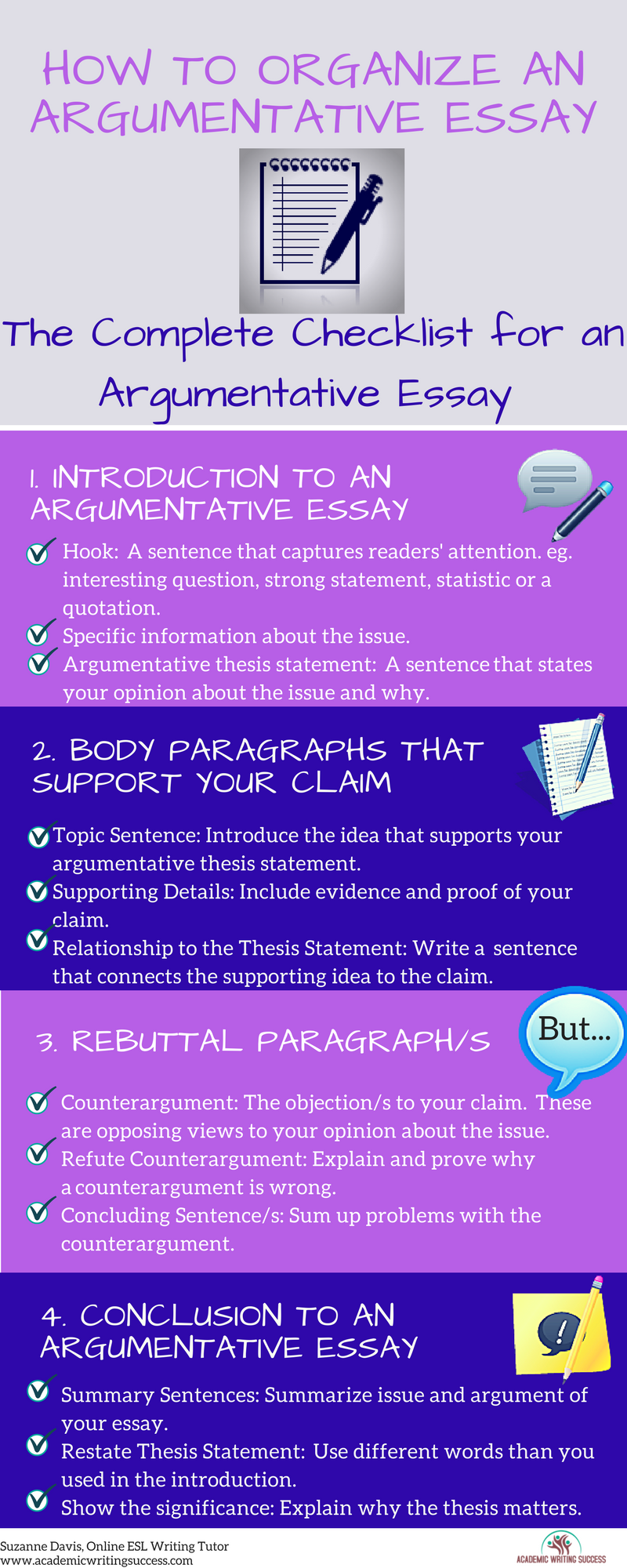Can you argue with me (in writing)?

That’s what I want my students to do. I want them to write a compelling argumentative essay that debates and challenges a point of view on a topic. And the secret to accomplishing that is knowing how to organize an argumentative essay. If you understand the parts and pieces that make up an outstanding argumentative essay, then you can write thorough, detailed, and persuasive content.
So, what’s an argumentative essay? It’s an essay where you take a stand on an issue and explain why your position is correct. It’s important to create an argumentative essay that explains and proves your thesis.
The key to doing this is by following a strong argumentative essay plan. There are other ways to organize your argumentative essay. But in this post, we’ll look at an easy plan that covers all the major parts you need in your essay.
And check out the video below to see how to use a checklist to help you organize an argumentative essay.
How to Organize an Argumentative Essay
The key pieces of this argumentative essay plan are:
- Introduction
- Body paragraphs that support the thesis
- Rebuttal paragraph/s
- Conclusion
The Introduction to an Argumentative Essay
Your introduction is how you show the reader your point of view about the issue. It also sets up the organization of the rest of your essay. A solid introduction is a powerful way to start your essay. The elements of an argumentative essay introduction are:
Hook: This is a sentence that captures grabs your readers’ attention. A hook makes them curious about the topic of your essay.
4 hooks work great with argumentative essays:
- Ask an interesting question
- State a fact/statistic
- Make a strong statement
- Include a relevant and important quotation
Each of these hooks should relate to the specific topic in your paper.
For more information about essay hooks see-http://www.academicwritingsuccess.com/7-sensational-types-of-essay-hooks/
 Specific Information about the Issue: The next few sentences of your introduction focus on explaining your topic. You include background information about the issue and why it’s important.
Specific Information about the Issue: The next few sentences of your introduction focus on explaining your topic. You include background information about the issue and why it’s important.
Ask yourself why does this topic matter? Who does it concern? Write about that in these sentences leading up to your thesis statement.
Thesis Statement: The last sentence is your argumentative essay thesis statement. A thesis statement is your opinion about the main topic of your essay or paper.
An argumentative thesis statement begins with a debatable topic/issue. The thesis statement is your point of view about that issue and how you will prove it. This is the claim of your argumentative essay.
An example argumentative essay thesis statement is: Assault rifles should be banned in the United States because these weapons can kill many people in a matter of seconds.
Next, you write the body of your essay so that it supports this claim and overpowers arguments against it.
The Body of an Argumentative Essay
The body of an argumentative essay has 2 parts: Paragraphs that support your claim and 1 or 2 rebuttal paragraphs.
Supporting paragraphs and rebuttal paragraphs reflect the pros and cons of your claim about the issue.
Body Paragraphs that Support Your Claim
Topic Sentence: This sentence is a supporting idea related to your thesis statement. The main topic of the paragraph is the supporting idea.
Supporting Details: This is the substance of your paragraph. Supporting details are evidence that proves the supporting idea.
Relationship to the thesis statement: This is a concluding sentence that shows how the supporting idea ties back to your thesis statement. It will also connect or lead into the next paragraph that supports your claim.
Write a body paragraph for each of the ideas that support your claim.
Rebuttal Paragraph in an Argumentative Essay
A rebuttal paragraph is important because it shows you considered two sides of an issue. You thought about the other side of an issue, researched it, and found a way to argue against it.
This is a crucial part of your argumentative essay because it’s where you overrule other peoples’ objections.
The 3 parts of the rebuttal paragraph are:
- Counterargument
- Refuting the counterargument
- Concluding Sentence
Counterargument: A counterargument is an objection to your claim. You develop this by thinking of all the things the people opposed to your perspective.
The thesis statement from above is: Pinterest is the best social media platform for small online businesses to advertise their products and services because many people use Pinterest to make buying decisions.
Your counterargument is a reason/s people would argue against that claim:
Ex. Facebook is the largest social media platform, and more people visit Facebook every day. Most people only visit Pinterest a few times a week.
Refuting the counterargument: Here, you explain and prove why these counterarguments are wrong.
Ex. Yet, people who use Pinterest are 10% more likely to buy something they saw on Pinterest than on any other social media platform. https://blog.hootsuite.com/top-social-media-sites-matter-to-marketers/
Concluding sentence: This last part of the rebuttal paragraph sums up the problem with the counterargument.
The Conclusion to an Argumentative Essay
Your conclusion should show readers what you proved and why your thesis matters. These are the things you include in a conclusion to an argumentative essay:
Summary Sentences: Here, you recap the main points of your claim.
Restate the thesis statement: Use different words to restate your claim.
Significance: Here, you explain why the thesis you proved in your argumentative essay matters. Consider how it affects other people, the field you study, or the world. Ask yourself, “What should the reader take away from my paper?”
A solid plan for your argumentative essay will help you see the weaknesses and strengths in your argument before you start writing your essay. You can follow this same organization when you write a longer argumentative paper. The difference is that you add more supporting and rebuttal paragraphs to a longer paper.
Learn how to organize an argumentative essay, and you’ll find it easier to write and revise an argumentative paper too.
Download your free copy of “The Ultimate Argumentative Essay Checklist” to help you write and revise your next argumentative essay.



Wow, this is the most detailed and easy to follow explanation of how to write an argumentative essay. Thank you for how precise and clear you are.
You are very welcome. It’s much easier to write an argumentative essay with a clear plan for how to do things.
Yes it is.
Suzanne, I love learning English once more. Most facts are long forgotten due to non-usage of those. But knowing and putting one’s knowledge into practice are completely two different things which is where your guidance becomes so crucial.
Nilanjana, I am glad you like learning English again. There is a difference between knowing a language and using it regularly. Please feel free to share any ideas of things you would like to learn. I love to write about English and writing.
This is an excellent article that give clear directions on how to approach argumentative essays. Students should always value a checklist and use it often. Writing is so much easier with a plan of attack!